Top 10 Asuras in Hinduism have some of the most powerful, surprising, and thought-provoking stories you’ll ever hear.
These aren’t just tales of demons—they’re deep, meaningful lessons about ego, devotion, power, and the choices we make.
You might know a few famous names like Ravana or Hiranyakashipu, but the full list will truly amaze you. Ever wondered how some Asuras were so devoted they earned boons from the gods, yet still met tragic ends?
Or how their stories are connected to natural forces and cosmic balance? Keep reading—you’ll discover fascinating facts, real symbolism, and powerful examples that will give you a new perspective on Hindu mythology.
Top 10 Asuras in Hinduism: Powerful Demons with a Divine Backstory
In Hindu mythology, the stories of Asuras often highlight the thin line between power and destruction. Asuras and Devas were born from the same divine origin—Prajapati.
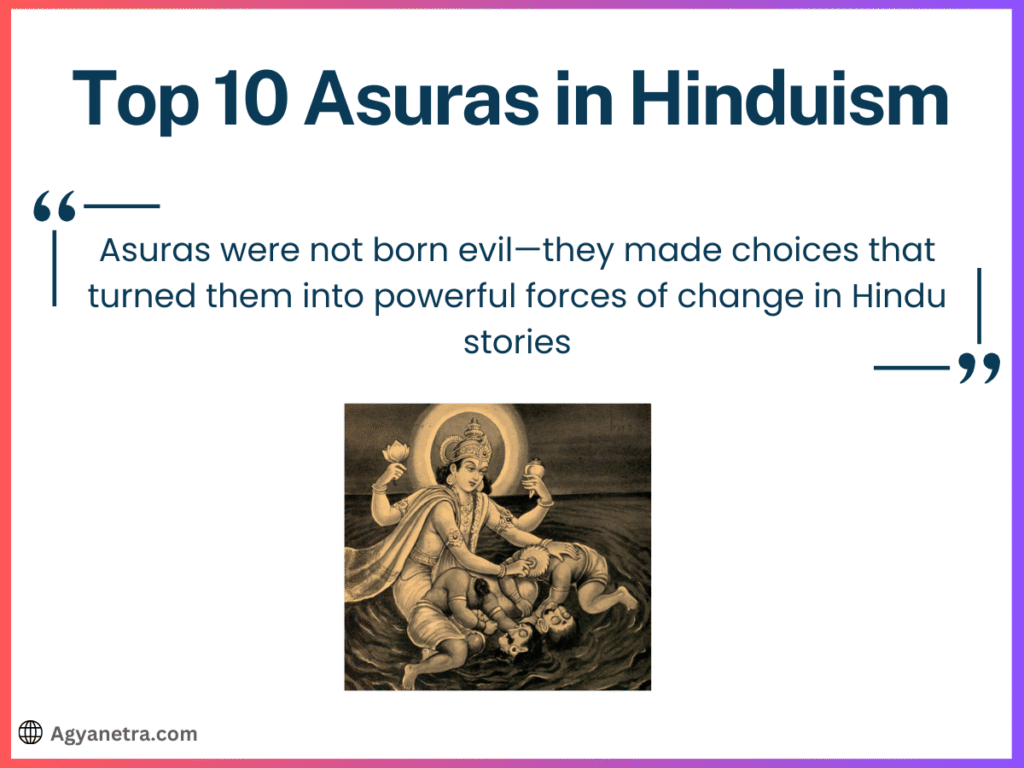
They shared the same world, lived together, and possessed immense intelligence, spiritual powers, and knowledge. But what truly separated them was their intention, mindset, and choices.
While many Asuras were deeply spiritual and intelligent, some became symbols of ego, destruction, and imbalance. These mythological demons played key roles in the cosmic stories told in Hindu scriptures.
Let’s explore the most powerful Asuras in Hinduism and understand their stories, characteristics, and the lessons they leave behind.
1. Madhu and Kaitabha – The Asuras Born from Vishnu’s Earwax
At the very beginning of the universe, Lord Vishnu was asleep on the cosmic ocean. From the dirt in his ears, two powerful Asuras—Madhu and Kaitabha—emerged.
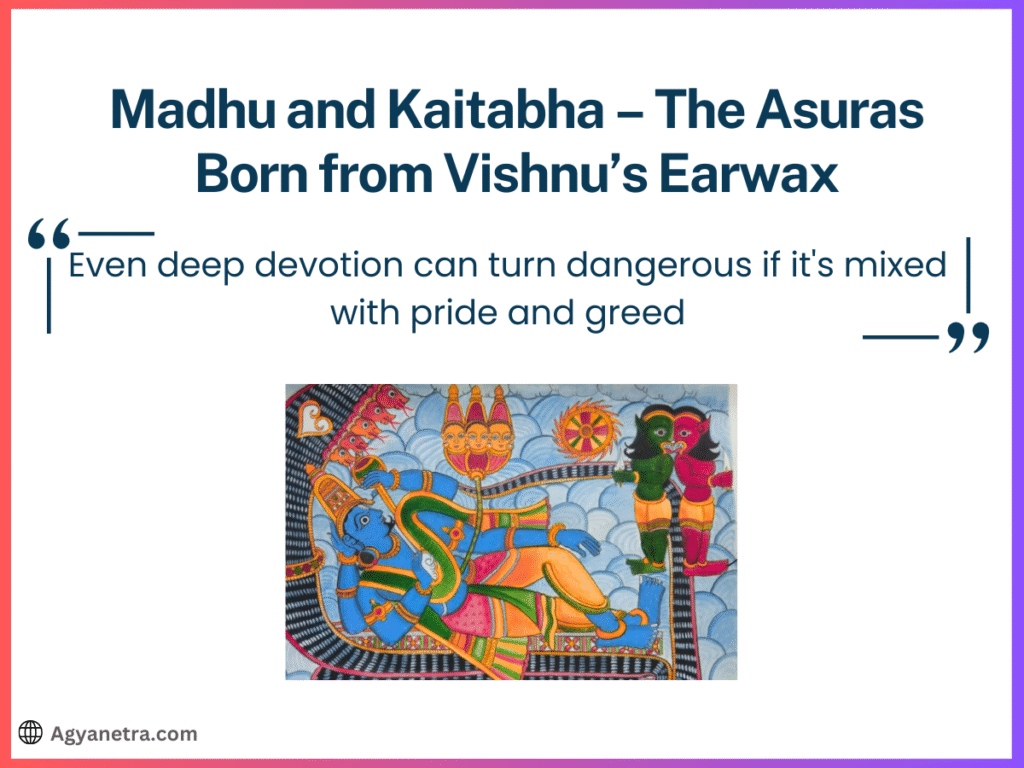
Despite their demonic origin, they were deeply curious and meditated for years to understand the truth of their existence.
Their intense devotion pleased Goddess Saraswati, who granted them a boon to choose their time and method of death.
However, their arrogance grew, and they stole the Vedas from Brahma and hid them in the ocean. To restore order, Lord Vishnu took the form of Hayagriva and defeated them.
Their bodies are said to have split into twelve parts, symbolizing the Earth’s twelve tectonic plates—a fascinating blend of mythology and ancient symbolism.
This story reminds us that even great knowledge can lead to destruction when guided by ego and not humility.
More Posts Like This
- What Is the Significance of Pancha Bhutas in Hinduism
- What Is Tantra in Hinduism
- How Hinduism Defines Twin Flames
- What Are the Four Yugas in Hinduism
2. Ravana – The Ten-Headed Genius and King of Lanka
Ravana is perhaps the most well-known Asura in Hindu mythology. With ten heads symbolizing his vast knowledge and intellect, Ravana was not just a demon king—he was also a scholar, musician, and expert in Ayurveda.
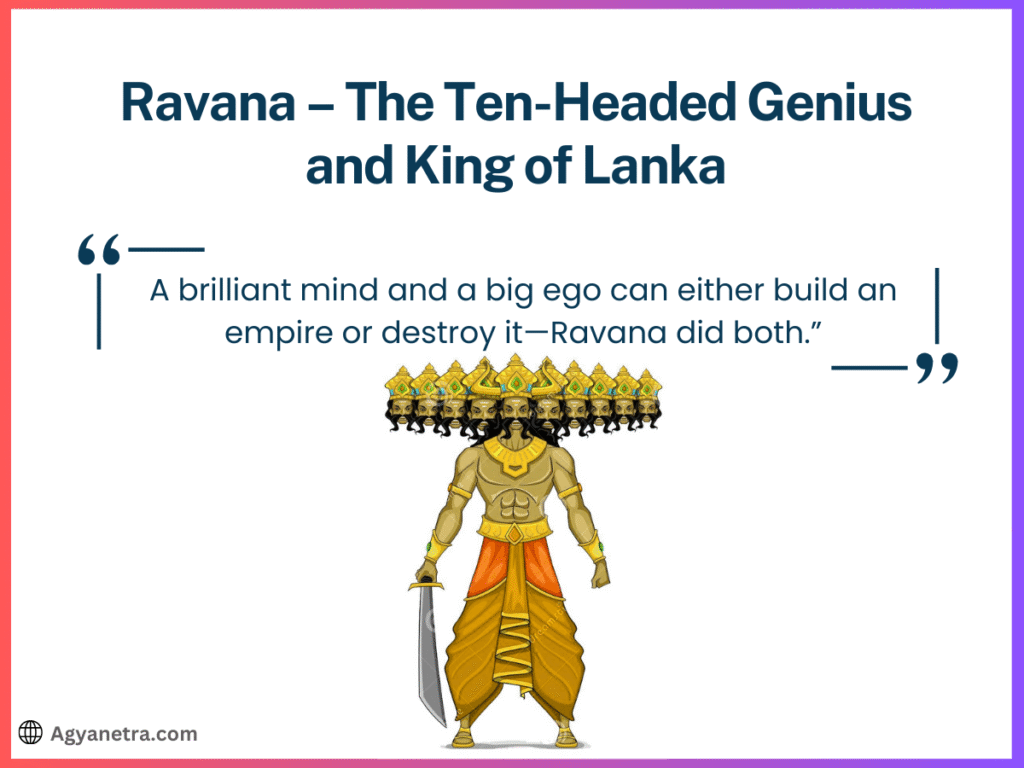
He is believed to have authored the Lal Kitab, a text on astrology and palmistry.
Though he abducted Sita and became the main antagonist in the Ramayana, Ravana’s character is layered. Lord Rama himself asked Lakshman to learn from Ravana’s wisdom and governance before his death.
His musical talent was so great that when he played the Veena, even the gods would come to listen.
Ravana’s story shows that intelligence and devotion, when misused with pride and ego, can lead to one’s downfall.
3. Vritra – The Dragon of Drought and Blocked Rivers
Vritra was a serpent-like demon known for blocking rivers and causing droughts. He was a powerful symbol of natural disasters and chaos.
According to the Rigveda, Vritra was the arch-enemy of Indra, the king of the Devas.
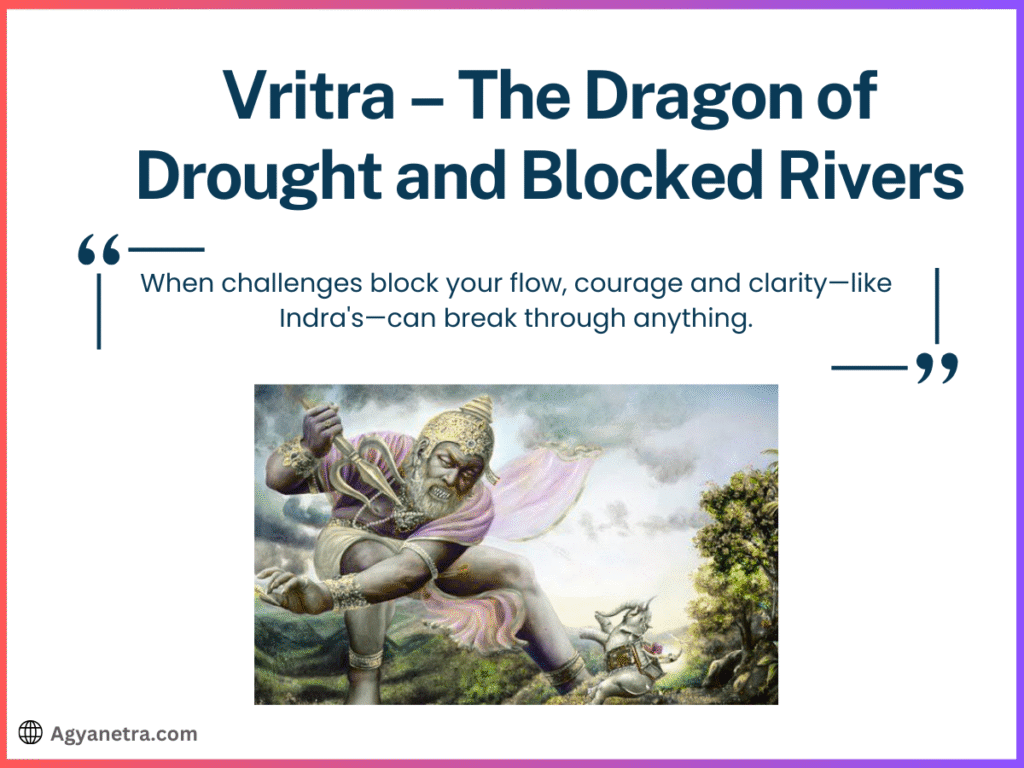
Vritra built 99 fortresses to protect himself. But Indra, armed with the divine thunderbolt Vajra, destroyed them and killed Vritra.
This act earned him the name Vritrahan, meaning the slayer of Vritra.
This battle between Indra and Vritra represents the constant struggle between order and chaos, nature and destruction.
4. Meghanada (Indrajit) – The Warrior Son of Ravana
Meghanada, also known as Indrajit, was the eldest son of Ravana and one of the greatest warriors in Hindu mythology.
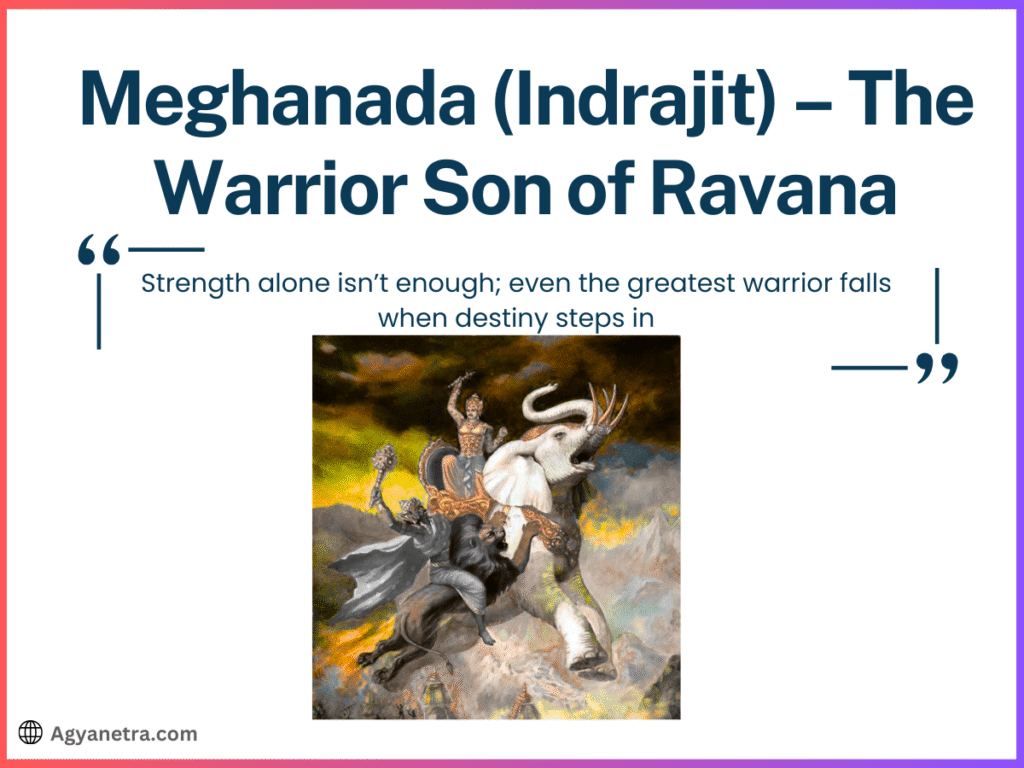
His name “Indrajit” means “conqueror of Indra,” showing how powerful he was.
He had the rare ability to become invisible during battle and was skilled in black magic.
According to legend, he could only be killed by someone who hadn’t slept for 14 years and lived only on fruits—qualities that matched Lakshman.
During the war, Indrajit would worship his family goddess (Kuldevi) to gain strength. If the worship was interrupted, it would make him vulnerable.
Lakshman disrupted the ritual and eventually killed him in a fierce battle. Indrajit’s story teaches us that even the strongest warriors are not invincible when fate turns against them.
5. Hiranyakashipu – The Arrogant King Who Wanted to Be God
Hiranyakashipu, the father of Prahlad, was a powerful Asura king. He received a boon from Lord Brahma that made him nearly indestructible—he couldn’t be killed by man or beast, inside or outside, during day or night, on earth or in the sky.

With this power, he declared himself as God and demanded worship from everyone, including his own son. But Prahlad remained devoted to Lord Vishnu.
Ultimately, Lord Vishnu appeared in his Narasimha avatar—half man, half lion—and killed Hiranyakashipu at twilight, on the doorstep, placing him on his lap, bypassing the boon’s conditions.
This story emphasizes the power of true devotion and the downfall of unchecked arrogance.
6. Raktabija – The Demon Who Multiplied with Every Drop of Blood
Raktabija was one of the most difficult Asuras to kill. Every time a drop of his blood fell to the ground, a new clone of him would emerge.
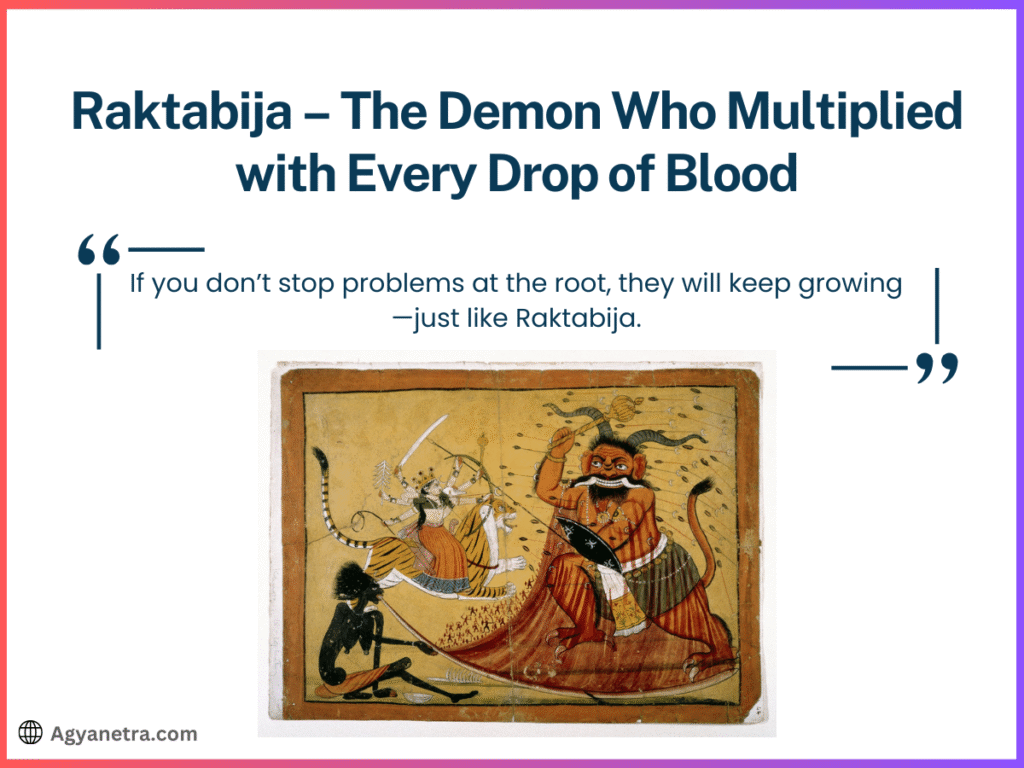
In a desperate battle, Goddess Kali appeared. To stop him from multiplying, she stretched her tongue over the earth and drank all the blood before it could touch the ground.
She devoured every duplicate and ultimately destroyed Raktabija.
His story represents how negative energy can grow uncontrollably if not stopped at the root.
Kali’s fierce solution shows how sometimes only divine intervention can bring peace when evil becomes too powerful.
7. Rahu – The Shadowy Demon Who Swallowed the Sun and Moon
During the Samudra Manthan (churning of the ocean), the Asuras and Devas were both trying to get Amrit—the nectar of immortality.
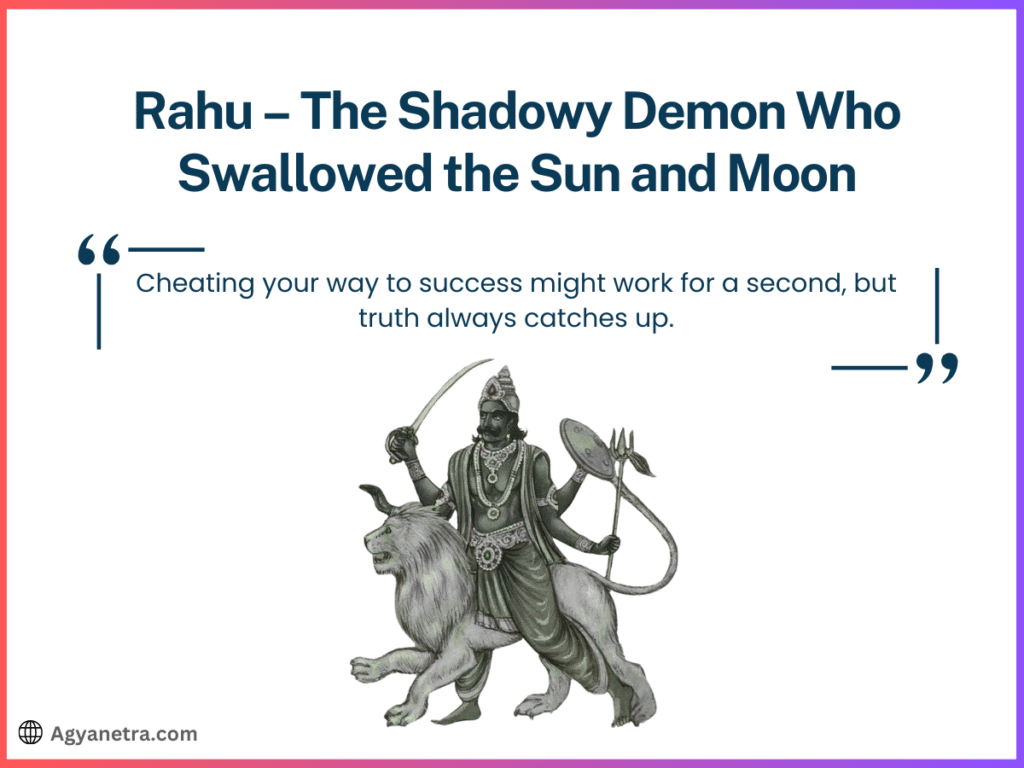
Rahu, an Asura, disguised himself as a Deva and managed to take a sip of the nectar.
However, the Sun and Moon spotted him and informed Lord Vishnu. Vishnu cut off Rahu’s head before the nectar passed through his entire body.
As a result, Rahu’s head became immortal and turned into a shadow planet. His body, known as Ketu, also became a planet.
Even today, eclipses in Hindu mythology are said to occur when Rahu swallows the Sun or Moon in revenge.
Rahu and Ketu are associated with karma, illusion, and spiritual lessons in Vedic astrology.
8. Hiranyaksha – The Demon Who Tried to Drown Mother Earth
Hiranyaksha, the brother of Hiranyakashipu, was known for his cruelty and brute strength. He attacked the heavens and kidnapped the Earth Goddess, dragging her into the cosmic ocean.
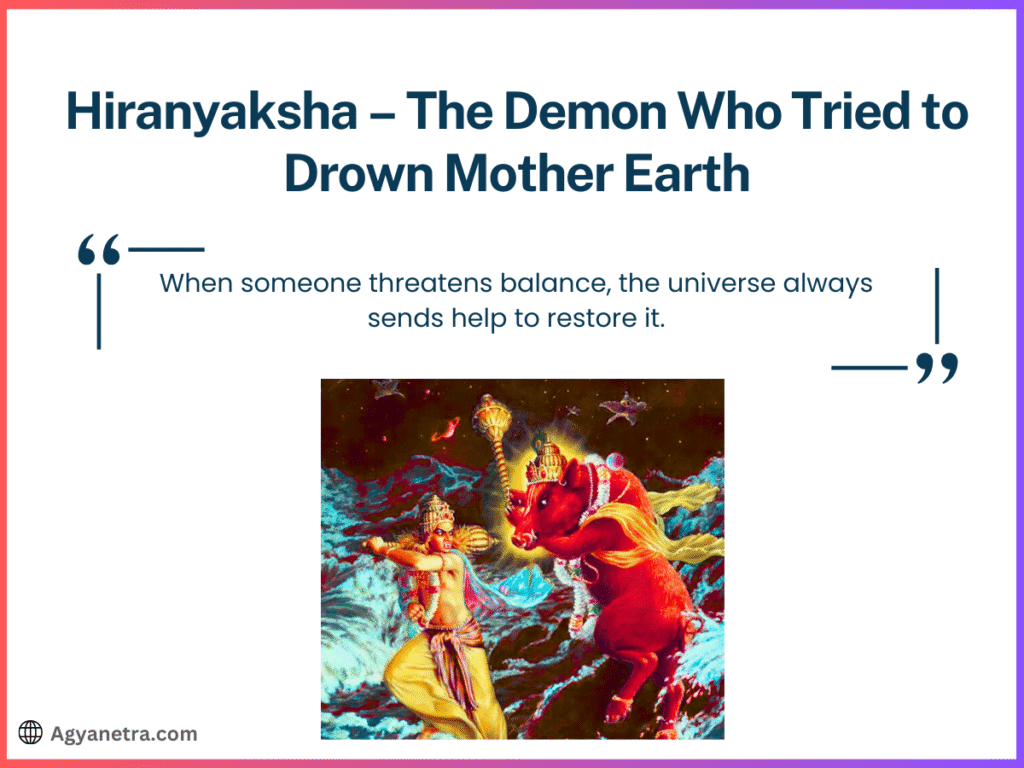
The gods pleaded with Lord Vishnu for help. Vishnu took the Varaha (boar) avatar and dived into the ocean to rescue her. A great battle followed, and Hiranyaksha was finally killed.
This myth explains the Varaha avatar’s role in saving the Earth and reflects the importance of balance between nature and power.
9. Banasura – The Thousand-Armed Devotee of Lord Shiva
Banasura was a powerful king with a thousand arms and ruled present-day Assam. He was a staunch devotee of Lord Shiva, who had granted him protection. However, Banasura grew arrogant and cruel.
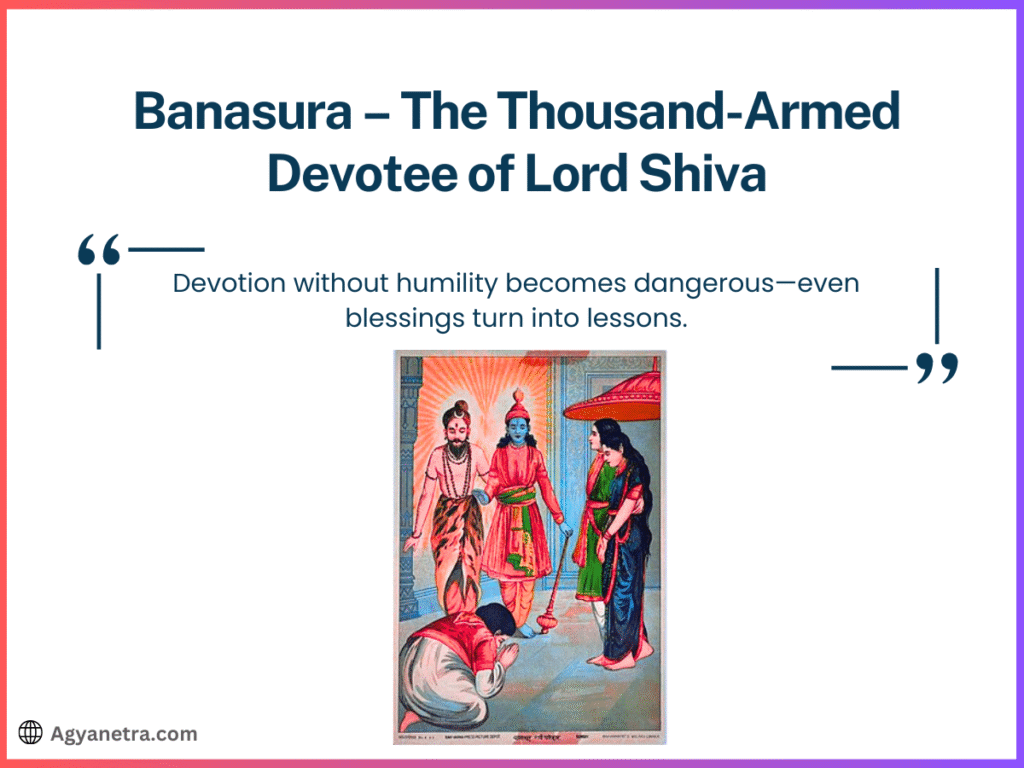
His daughter, Usha, fell in love with Aniruddha, Lord Krishna’s grandson. When Aniruddha was abducted and kept in a fortress, Krishna attacked.
After a fierce battle, Krishna cut off all but two of Banasura’s arms.
Lord Shiva intervened and pleaded for his devotee’s life. Krishna forgave Banasura, and Usha was allowed to marry Aniruddha.
This story shows how even demons can be redeemed through repentance and divine grace.
10. Bhasmasura – The Demon Who Burnt Himself with His Boon
Bhasmasura was granted a deadly boon by Lord Shiva—the power to turn anyone into ashes just by placing his hand on their head. But as is common with unchecked power, he misused it.
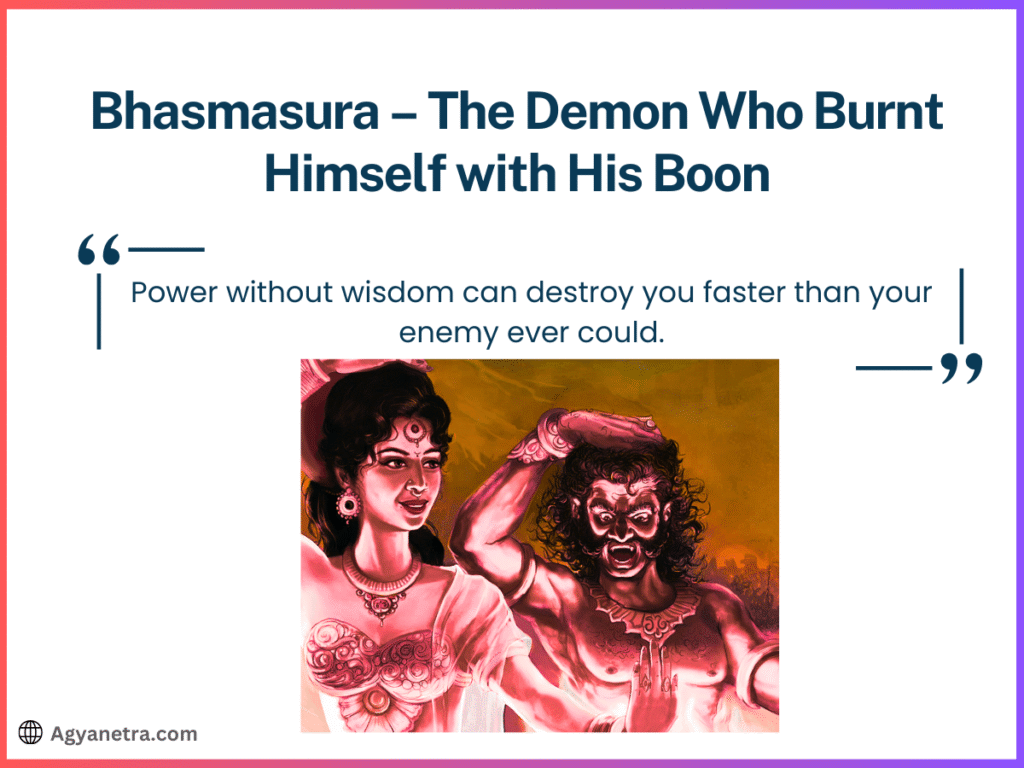
Bhasmasura even tried to use the boon on Shiva himself. Shiva ran to Vaikunth and sought help from Lord Vishnu.
Vishnu took the form of the beautiful Mohini and distracted Bhasmasura with a dance.
During the dance, Mohini placed her hand on her head, and Bhasmasura copied the move—turning himself into ashes.
This tale is a perfect example of how wisdom can defeat brute strength and how pride often leads to self-destruction.
Conclusion
These stories of the top 10 Asuras in Hinduism are more than just myths—they carry deep spiritual messages.
While Asuras often symbolize negative qualities like ego, arrogance, and chaos, they also reflect powerful lessons about devotion, wisdom, and self-control.
From Ravana’s unmatched intelligence to Raktabija’s multiplying curse, each Asura’s story teaches us something valuable.
Whether it’s Rahu’s shadowy presence or Hiranyakashipu’s downfall by divine design, Hindu epics show that good and evil are not always black and white—they’re shaped by choices, intentions, and actions.
Understanding these mythological demons helps us grasp the balance between power and humility, knowledge and arrogance, and devotion versus ego.
These ancient stories continue to guide and inspire millions through the symbolic roles of Asuras and Devas in Hindu scriptures.
Let the legends of the top 10 Asuras in Hinduism remind us to choose the path of truth, wisdom, and balance in our own lives.
FAQs
Who are the top 10 Asuras in Hindu mythology?
The top 10 Asuras in Hinduism include Madhu, Kaitabha, Ravana, Vritra, Meghanada (Indrajit), Hiranyakashipu, Raktabija, Rahu, Hiranyaksha, Banasura, and Bhasmasura. Each of them played powerful roles in ancient stories, often symbolizing ego, chaos, or imbalance in the universe.
What is the difference between Asuras and Devas in Hinduism?
Asuras and Devas come from the same origin—Prajapati—but differ in mindset. Devas choose righteousness and balance, while Asuras often choose ego, power, and control. The key difference lies in their actions and intentions, not just their form.
Why is Ravana considered a powerful Asura?
Ravana is considered powerful because of his unmatched intelligence, mastery over scriptures, music, and Ayurveda. Though he was a demon king, he was also deeply spiritual and had earned boons through devotion. His pride, however, led to his downfall.
Is Rahu really an Asura or a planet in astrology?
Rahu was originally an Asura who tried to steal Amrit during Samudra Manthan. After being exposed, his head was cut off by Lord Vishnu. Rahu later became a shadow planet in Vedic astrology, known for affecting karma, illusions, and eclipses.
What lesson does Bhasmasura’s story teach us?
Bhasmasura’s story teaches that power without wisdom can be self-destructive. His desire to test a deadly boon on Lord Shiva backfired when he was tricked by Mohini into destroying himself. It’s a reminder to think before using power.
How did Goddess Kali defeat Raktabija?
Goddess Kali stopped Raktabija’s blood from falling on the ground by drinking it with her tongue. Since each drop created a clone, she had to prevent any spill. This creative solution helped her defeat him completely, showing that strategy matters in battle.
What makes Meghanada (Indrajit) a unique warrior among Asuras?
Indrajit was one of the few warriors who defeated Indra and became invisible in battle. He performed secret rituals for protection. His death came only when those rituals were interrupted. His story shows that faith and fate both influence battles.

Vidushi Gupta is an accomplished writer and digital marketing expert with contributions to organizations like Miles Educomp and ICAI. She has authored nearly ten novels and worked as a Senior Content Writer and Digital Marketing Specialist at ESS Global and Shabd. Her Quora posts have amassed almost 20 million views, reflecting her belief in the transformative power of the written word.

